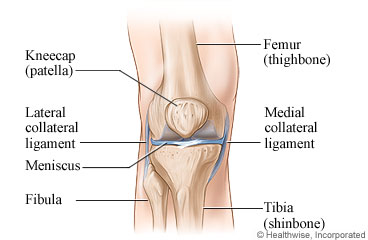
Overview
A knee sprain is one or more stretched, partly torn, or completely torn knee ligaments. Ligaments are bands of ropelike tissue that connect bone to bone and make the knee stable. The knee has four main ligaments.
Knee sprains often happen because of a twisting or bending injury from sports such as skiing, basketball, soccer, or football. The knee turns one way while the lower or upper leg goes another way. A sprain also can happen when the knee is hit from the side or the front.
If a knee ligament is slightly stretched, you will probably need only home treatment. You may need a splint or brace (immobilizer) for a partly torn ligament. A complete tear may need surgery. A minor knee sprain may take up to 6 weeks to heal, while a severe sprain may take months.
Follow-up care is a key part of your treatment and safety. Be sure to make and go to all appointments, and call your doctor if you are having problems. It's also a good idea to know your test results and keep a list of the medicines you take.
How can you care for yourself at home?
- Follow instructions about how much weight you can put on your leg and how to walk with crutches.
- Prop up your leg on a pillow when you ice it or anytime you sit or lie down for the next 3 days. Try to keep it above the level of your heart. This will help reduce swelling.
- Put ice or a cold pack on your knee for 10 to 20 minutes at a time. Try to do this every 1 to 2 hours for the next 3 days (when you are awake) or until the swelling goes down. Put a thin cloth between the ice and your skin.
- Follow your doctor's directions for wearing an elastic bandage, a splint, or a brace (immobilizer). Wrapping the knee may help reduce or prevent swelling.
- Ask your doctor if you can take an over-the-counter pain medicine, such as acetaminophen (Tylenol), ibuprofen (Advil, Motrin), or naproxen (Aleve). Be safe with medicines. Read and follow all instructions on the label.
- Do not take two or more pain medicines at the same time unless the doctor told you to. Many pain medicines have acetaminophen, which is Tylenol. Too much acetaminophen (Tylenol) can be harmful.
When should you call for help?
Call 911 anytime you think you may need emergency care. For example, call if:
- You have sudden chest pain and shortness of breath, or you cough up blood.
Call your doctor now or seek immediate medical care if:
- You have increased or severe pain.
- You cannot move your toes or ankle.
- Your foot is cool or pale or changes color.
- You have tingling, weakness, or numbness in your foot or leg.
- Your splint or brace feels too tight.
- You are unable to straighten the knee, or the knee "locks."
- You have signs of a blood clot in your leg, such as:
- Pain in your calf, back of the knee, thigh, or groin.
- Redness and swelling in your leg.
Watch closely for changes in your health, and be sure to contact your doctor if:
- Your pain is not getting better or is getting worse.
Where can you learn more?
Go to http://www.healthwise.net/patientEd
Enter N406 in the search box to learn more about "Knee Sprain: Care Instructions".
Current as of: July 17, 2023
Author: Healthwise Staff
Clinical Review Board
All Healthwise education is reviewed by a team that includes physicians, nurses, advanced practitioners, registered dieticians, and other healthcare professionals.

